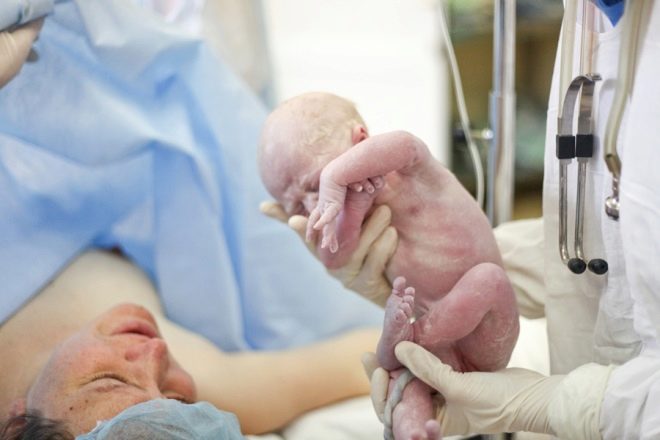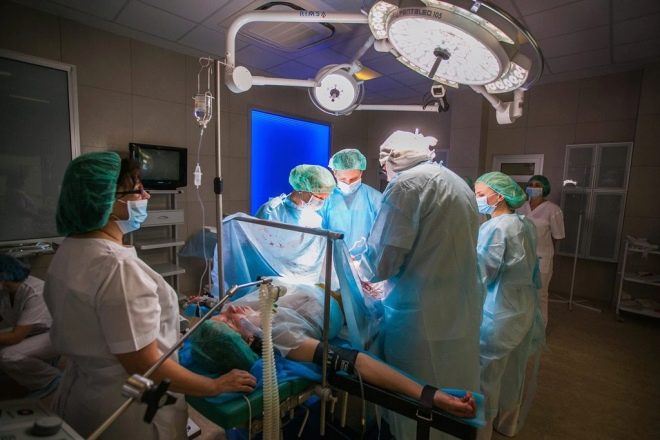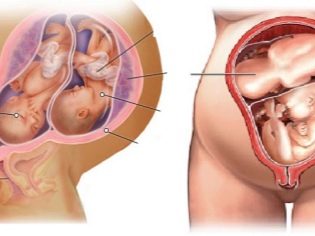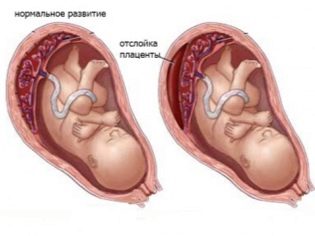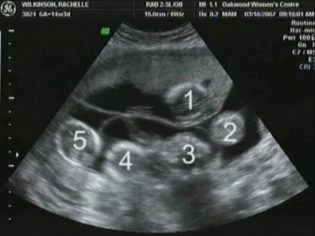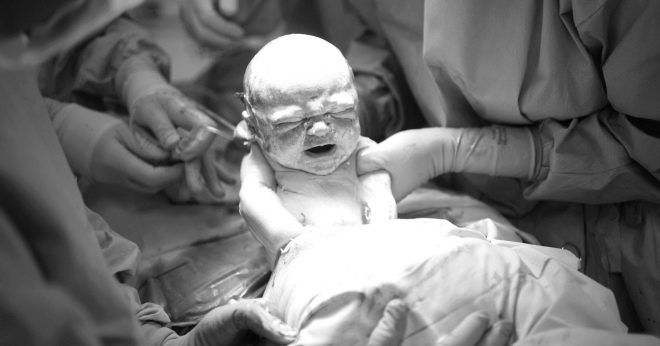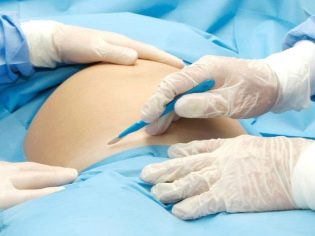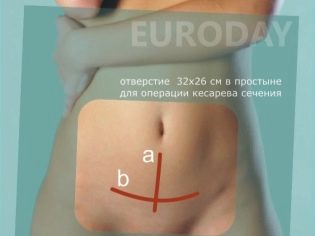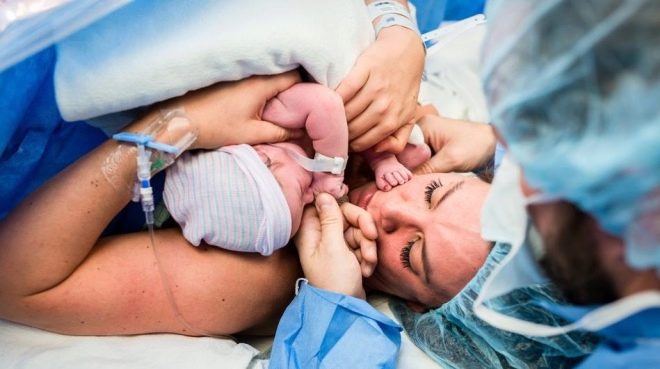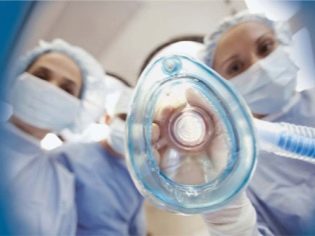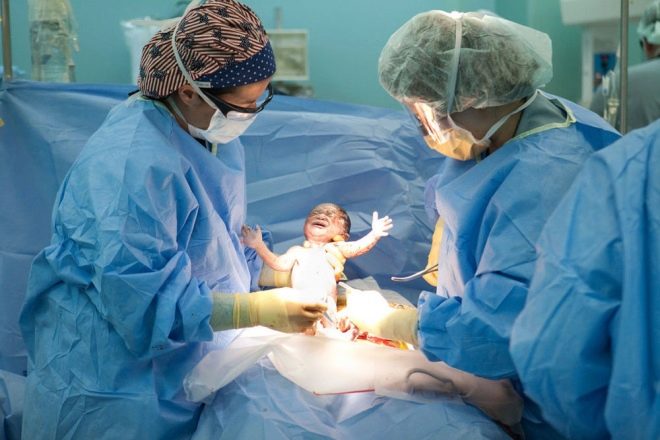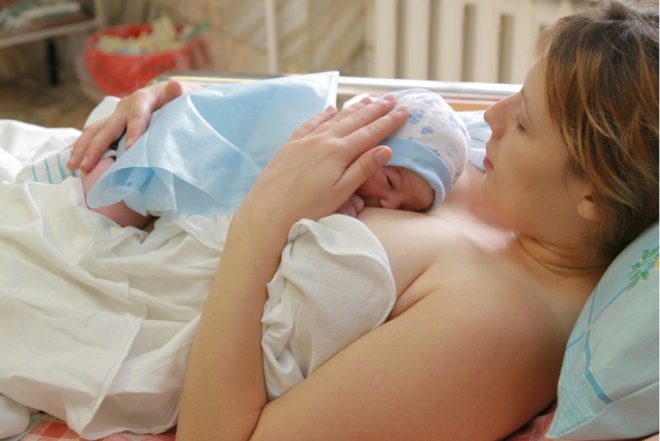Pros and cons of cesarean section. Are there often negative consequences?
The proportion of abdominal delivery has grown, and today every fifth pregnancy ends with a cesarean section, not natural birth. The operation has its unconditional advantages and disadvantages. We will tell you about the advantages and disadvantages of surgical births, how likely they will develop complications after them, in this article.
Who is shown the operation?
Caesarean section is an alternative method of delivery, in which the baby is not born in the traditional way, but through incisions in the anterior abdominal wall and uterus. The operation, despite its apparent simplicity and wide distribution, belongs to the category of complex surgical abdominal procedures. That is why in Russia it is not carried out at will, at least in state maternity hospitals, perinatal centers and clinics. Only a few private clinics provide the likelihood of elective cesarean (surgery on the woman’s own will). In these clinics, this service costs about half a million rubles.
The list of situations in which it is safer and more rational to give birth surgically is specified and approved by the Ministry of Health of Russia (Letter of the Ministry of Health of 2014 No. 15-4 / 10 / 2-3190). Thus, a caesarean section is scheduled as planned in the following situations.
- low location of the placenta with complete overlap of the internal os or incomplete overlap, as well as previa with signs of detachment and bleeding;
- premature detachment of the "children's place" from the uterine wall, while the location of the placenta does not matter;
- two genera performed by caesarean section in the past, as well as any operations on the uterus, if scars have survived after them;
- the weight of the fetus is more than 3.6 kg with the wrong position of the child in the uterus (sitting, located across);
- the wrong location of one of the twins babies;
- multiple (often singleton) pregnancy after IVF;
- postponed pregnancy (at 41-42 week of gestational age), if other methods of stimulation of childbirth did not have the effect;
- any mechanical obstacles to the passage of the child through the birth canal - tumors, large groups of polyps, scars after ruptures of the cervix;
- the state of severe gestosis (with edema, large weight gain, signs of high blood pressure);
- a ban on attempts (with myopia, certain diseases of the cardiovascular system, transplanted donor kidney, etc.);
- state of acute oxygen starvation of the fetus (of any origin);
- umbilical cord prolapse;
- genital herpes primary type;
- HIV infection in the mother, if during the period of pregnancy the woman for some reason did not receive supportive treatment;
- narrow pelvis, in which independent labor will be difficult;
- bleeding disorders of the mother, fetus;
- malformations of the baby - omphalocele, gastroschisis, etc.
As for the emergency operation, there are other indications for it. An unplanned operation will be urgently performed to a woman in labor, in whom labor has unexpectedly weakened during labor, the cervix does not open, a secondary weakness of attempts is observed, the placenta has exfoliated, bleeding has opened. This will be an operation to save the lives of the mother and her long-awaited baby.
Technique of
The operation is performed using anesthesia. The patient has the full right to choose general anesthesia, in which she will sleep soundly during all surgical procedures. But the majority of surgical deliveries in Russia today are performed under epidural or spinal anesthesia, in which anesthetic preparations are injected into the epidural or subarachnoid space of the spine using lumbar puncture. In emergency caesarean section, when every minute counts, usually give general anesthesia, since there are practically no contraindications to it, and the state of unconsciousness comes faster.
After the woman is anesthetized or given general anesthesia, the surgical team proceeds with the operation. With planned intervention, try to make a horizontal incision of the abdomen just above the pubis in the lower uterine segment. During an emergency operation, if the child is threatened with death, they can make a vertical incision in the center of the abdomen through the navel.
After opening the abdominal cavity, the doctor frees up space for further "maneuvers" - takes muscle tissue and bladder aside. After this, an incision is made on the uterus, a bag of fetus is punctured and the amniotic fluid is drained. Then the surgeon gently head forward pulls the baby through the incision made.
Crumbs cut the umbilical cord and pass the baby to neonatologists. The woman is gradually restored first to the uterus, imposing internal sutures, then the abdominal cavity, returning the muscles and bladder to the anatomical initial condition, and stitching or stapling the skin outside.
A woman, if she is not under general anesthesia, will be able to see her child right away. If she is fast asleep, the meeting will be transferred and will take place only a few hours after birth.
In the intensive care ward, the newly-made mother is located several hours after the operation, after which she is transferred to the post-partum department in a regular ward, where after 8–10 hours after the intervention she can begin to sit, stand, walk.
Virtues
The undoubted advantage of cesarean section can be considered relatively predictable outcome of the intervention. The probability of birth injuries for both the child and his mother is minimal. There is no need for the child to go through narrow birth canals, and therefore there is practically no chance of injury to the neck or head during surgical birth. Whereas with a narrow pelvis or large baby in a pelvic presentation, injuries to the newborn and his mother during natural childbirth would be much more likely.
Caesarean section gives the opportunity to become mothers to women who are contraindicated in natural childbirth. And today, the quality of materials for suturing tissues and the surgical technique make it possible to give birth operatively not one or even two children, but as much as the woman wants.
With a caesarean section, the woman does not feel the pain of birth, which most frightens pregnant women and the memories of which are never erased from memory. There is some fear of what is happening in the parturient women with epidural anesthesia, but it is more psychological.
If general anesthesia is used, the woman simply falls asleep and wakes up in the status of a mother.
The use of spinal or epidural anesthesia can correct the deficiency that has not been eliminated for many years - a woman gets the right to see the baby immediately after it is removed from the womb, and it also becomes possible to attach the baby to the breast, which is very important for early lactation and full subsequent breastfeeding.
A caesarean section, if done in a planned manner, does not leave coarse, disfiguring scars on the patient's abdomen.Doctors do everything possible to seam was neat, unobtrusive, cosmetic, located in the area, which is usually well covered with shorts or swimming trunks. Each subsequent operation, if the woman has decided not to be limited to one child, is carried out on the same scar, new scars on the abdomen and uterus does not appear.
A cesarean section allows for additional surgical procedures. If there is a need to provide lifelong contraception, then the tubal ligation is performed simultaneously, and tumors in the uterus can be removed.
The duration of surgical delivery usually does not exceed 45 minutes, whereas natural childbirth can last up to a day or more.
disadvantages
Caesarean section is not a natural delivery, it is always a gross intervention in the work of the female body. If an operation is performed in a planned manner, then often the mother’s body is not actually ready for childbirth (contractions have not begun), so removing the child in an abdominal manner is a huge stress for both the mother’s body and the baby’s body.
Preparations that anesthesiologists use for anesthesia surgical procedures, affect not only the woman but also the baby, even if it comes to spinal anesthesia. A baby born with the help of a surgeon cannot have 9 points on Apgar in principle, since he is always more inhibited, sluggish - he is affected by anesthetics and muscle relaxants, which the mother has administered for anesthesia. True, after a few hours this action passes.
The baby is deprived of the opportunity to go the way prepared for him by nature - he does not overcome the resistance of the genital tract to be born, and this, according to some experts, will badly and necessarily affect the formation of his character in the future. So, it is argued that such children are less proactive, afraid of difficulties, have less stress resistance.
Many questions have not yet been fully studied, but the fact that the baby without passing through the sexual ways loses the opportunity to gently adapt to the new conditions in which he is to dwell is indisputable.
Assertions of some cesarean section adversaries that children grow up with a lag in development, need remedial programs, get sick more often, do not correspond to reality, therefore they cannot be considered as a disadvantage.
A cesarean section is dangerous due to its complications, and their probability increases by several dozen times compared with physiological independent labor. The recovery and rehabilitation period lasts much longer than after childbirth, breast milk comes a few days later. Ligation of the fallopian tubes, if it was carried out, lengthens the time of the operation and the recovery time of the woman’s body.
After a cesarean section, a woman for more than 2 years is not recommended to become pregnant again, whereas after physiological birth there is no such prohibition. It is harmful to lift weights, and in the absence of housekeepers, regular household chores and caring for a newborn become very difficult.
The harm from the operation, of course, does not exceed the benefit, but still you can never be sure that complications and negative consequences will bypass you.
Probability of complications
Complications are possible at any stage of the operation, as well as after it. During surgical procedures, bleeding from the vessels of the anterior abdominal wall may occur, and a mechanical injury to the bladder, ureters, and intestines may also occur if the vascular bundle is injured. If complications have arisen during the operation itself, the woman will not be placed in the intensive care unit, but in intensive care unit, where she will be monitored for several days, receive blood transfusions, if necessary, and inject the necessary drugs. The frequency of such complications does not exceed 0.01%.
Postoperative bleeding can also have dangerous consequences, as well as a violation of uterine contractility (hypotension or atony of the reproductive organ). In this case, medical assistance will be required, and the removal of the uterus is not excluded, if its muscles do not respond to the introduction of contraction drugs, the uterus does not decrease.
Severe vital complication of cesarean section - infectious inflammation. It can lead to the death of a new mother. Symptoms of inflammatory infectious complications - high fever, abdominal pain, discharge of atypical nature, wound suppuration, increased white blood cells in the blood test. Most often, after surgery, inflammation of the endometrium of the uterus (endometriosis) develops, but other situations are not excluded. Peritonitis is considered the most dangerous of all. In practice, given the sterility of modern operating rooms and the refinement of the actions of the surgical team, such complications are less common - only 0.7-1% of cases.
The danger to the child lies in the short-term exposure to anesthetics, which can lead to respiratory failure (0.003% of cases). Much more often, respiratory failure develops in newborns if the intervention was carried out at 36 weeks of pregnancy and earlier, but it is no longer associated with the operation itself, but with the gestational immaturity of the lung tissue of the fetus.
Much depends on a well-organized postoperative period.
If the requirements and recommendations of the doctor are not followed, the woman risks not to become a mother anymore, since an insolvent scar will form on her uterus that simply will not allow the next child to be carried out.
Problem prevention
For the prevention of inflammatory processes in case of suspicion of their likelihood, doctors prescribe antibiotics to the woman in the early postoperative period. Since more often than other complications occur in women with obesity, systemic concomitant diseases, with low social status and bad habits, as well as with impaired blood clotting, it is these women who fall into the zone of special attention of medical personnel.
To exclude hypotension or uterine atony Early attachment of the baby to the breast is recommended, as well as the introduction of reducing and pain medication. If a woman has undergone 3 or 4 such operations, it is recommended that more careful monitoring of the area of the uterine scar during the year, since it is thinner than that of those who underwent one or two operations.
A woman should not lift weights, also need to be protected. Sex life You can begin to live only when the discharge from the genitals stops, not earlier than 2 months after the birth of the baby. It is strongly not recommended to become pregnant for 2 years, the scar on the uterus is in the stage of intensive formation during this period.
During pregnancy, 4 months or a year after cesarean, weak and thin connective tissue in the incision area can not withstand the intensive growth of the uterus, which can lead to rupture of the muscular organ even during gestation.
According to the reviews of women left on the thematic forums on the Internet, there were no complications after the cesarean section performed by him. Due to the fact that they occur less frequently, there are almost no reviews describing the negative consequences. The majority of women note that the recovery went well, the scar on the abdomen healed approximately 3 weeks after the operation.
On the pros and cons of cesarean section, see the following video.

